Form 1 Grant Application Instrument and Instruction
Head Start Program Grant Application
Head Start Grant Application Instrument and Instructions-9-28-20
Head Start Grant Application
OMB: 0970-0207

Head Start
Grant Application
THE PAPERWORK REDUCTION ACT OF 1995 (PUB. L. 104-13)
Public reporting burden for this collection of information is estimated to average 33 hours per response, including the time for reviewing instructions, gathering and maintaining the data needed, and reviewing the collection of information.
An agency may not conduct or sponsor, and a person is not required to respond to, a collection of information unless it displays a currently valid OMB control number.
OMB
Control No: 0970-0207
Expiration date: xx/xx/xx
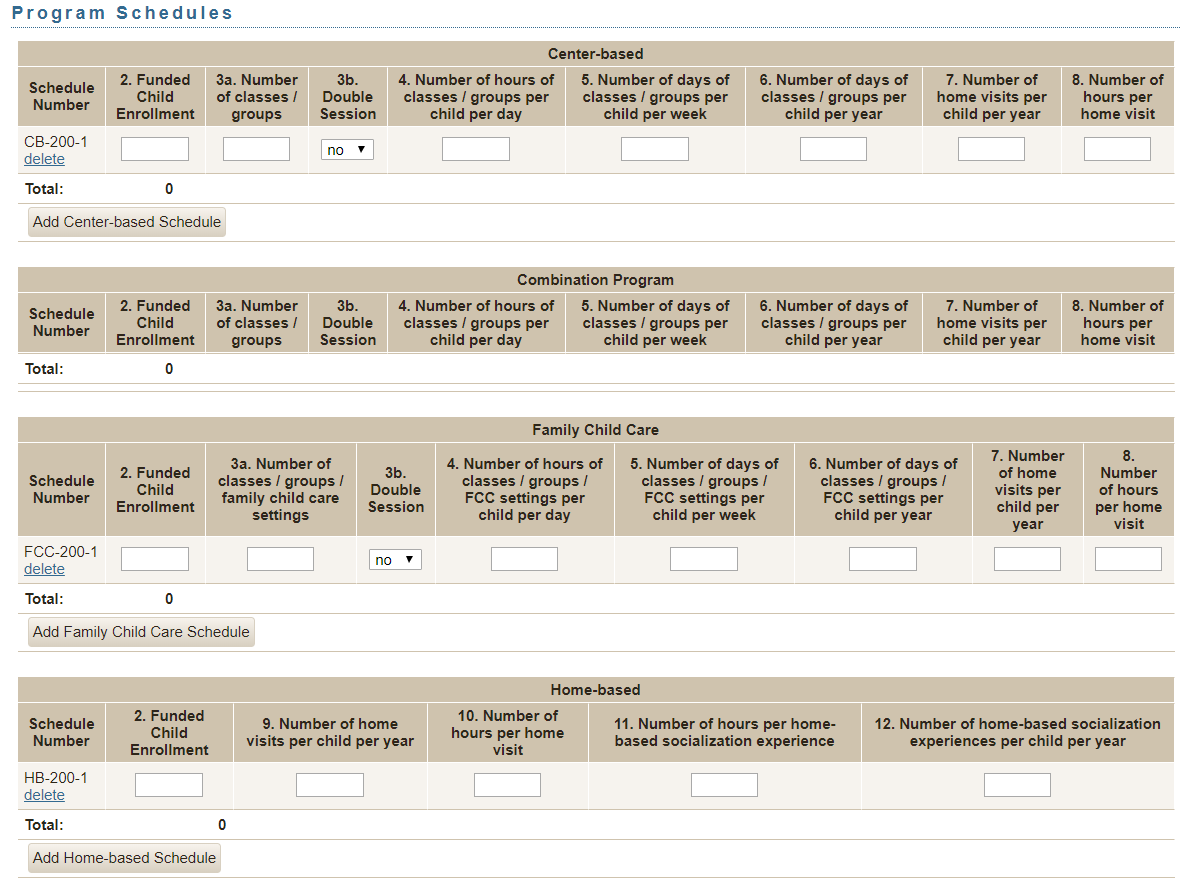


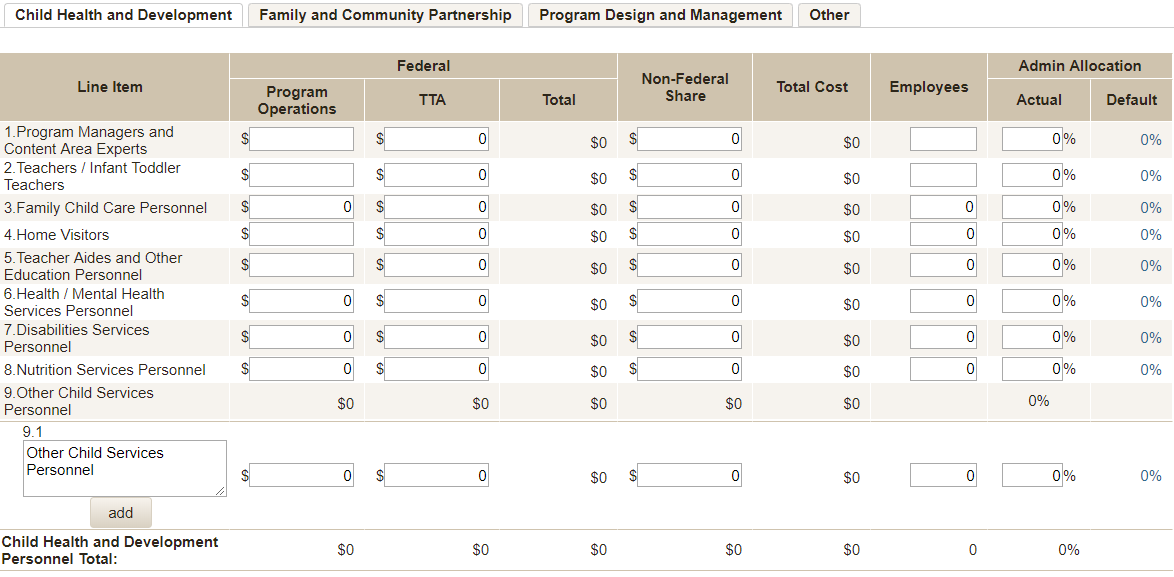

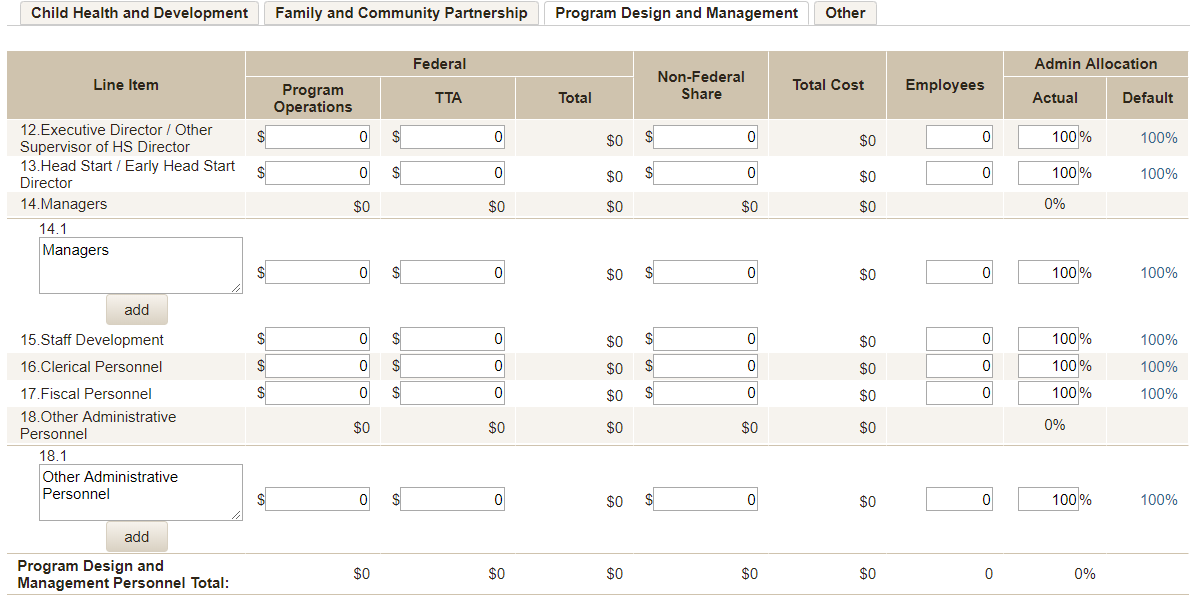

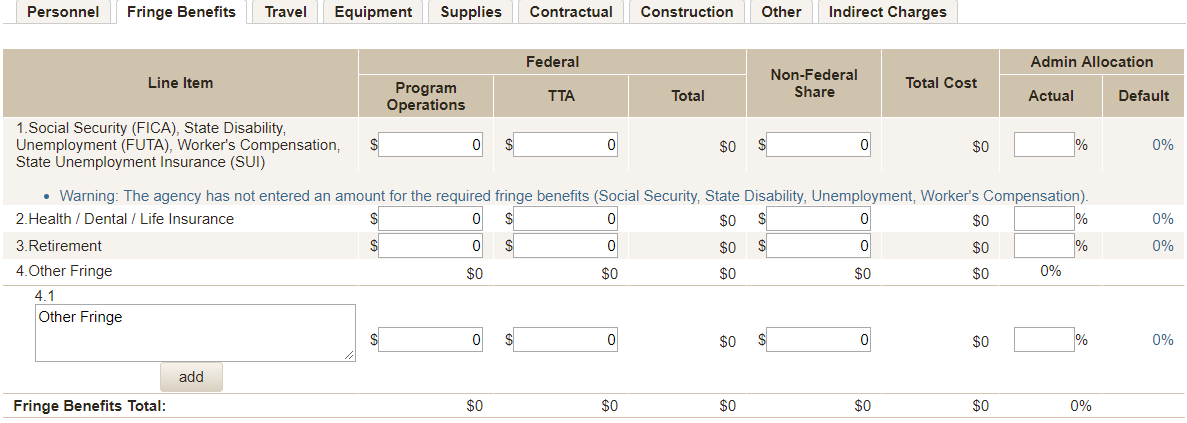



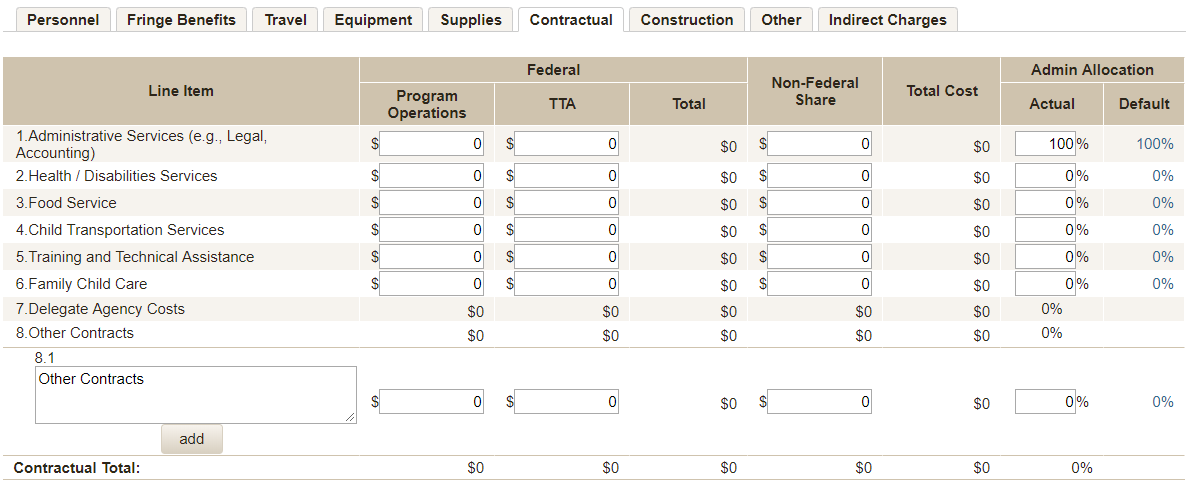

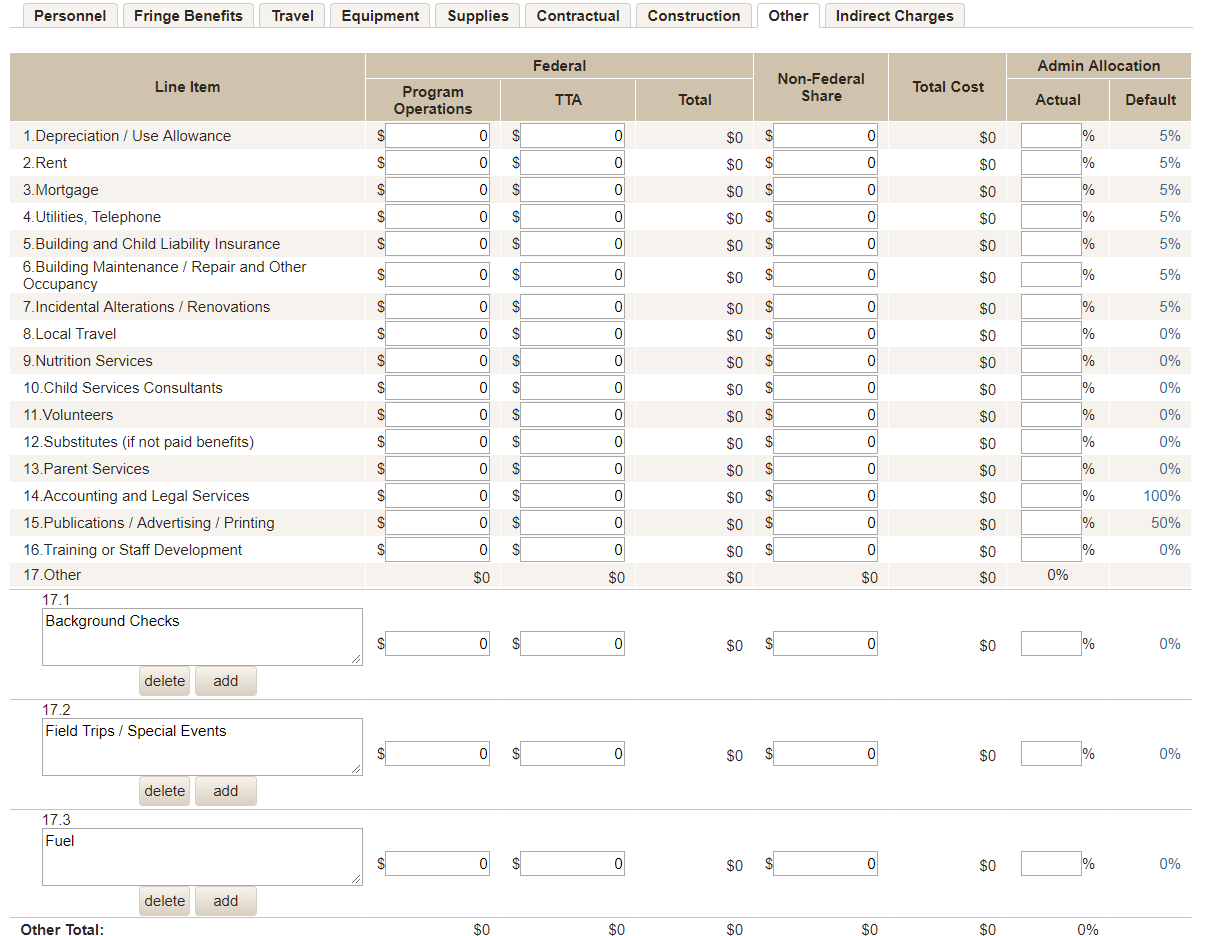

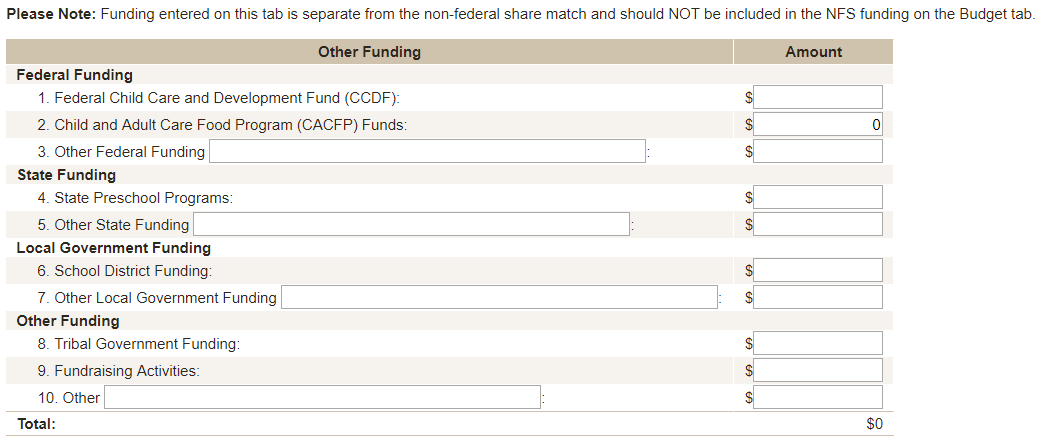
Additional Budget-Related Questions on COVID-19 Activities
Grant Name:
Grant Number:
You received [$XXXXX] of supplementary funding through [Authority Citation].
Please identify the percent of the total [“supplementary” or name of funding] funding you expect to spend on the following categories. Regardless of where your funds are on the SF424A, please estimate what share of your [“supplementary” or name of funding] funding you have spent or intend to spend for the following purposes. Note: the categories below do not align with the SF-424A budget line items; rather they reflect categories related to preventing, preparing for and responding to COVID-19. If any cost may fit more than one of the following categories, use the category that best describes the cost to ensure costs reported are not duplicated. Also, note that the parentheticals below each category do not include all possible examples but provide the types of expenses by category.
Later in the program year, OHS will request this form to be updated.
Costs associated with:
Select All that Apply |
Category |
Percent of [“supplementary” or name of funding] Funding projected to spend |
|
Equipment and Supplies
|
|
|
Equipment and supplies needed to support remote delivery of program services (Examples include electronic tablets, notebook computers, phone cards, technology upgrades, internet access – excluding educational supplies)
|
|
|
Equipment and supplies associated with reopening centers for in-person services with the appropriate preventive health measures (Examples include personal protective equipment, thermometers, additional cleaning materials and sanitizing supplies)
|
|
|
Educational supplies for all service delivery (in-person services in classroom, home-based settings, and remote delivery)
|
|
|
Transportation, including the purchase of buses, bus drivers, and other vehicles
|
|
|
Meals and snacks not reimbursed by USDA
|
|
|
Major renovations (Major renovation means any individual or collection of renovations that has a cost equal to or exceeding $250,000. It excludes minor renovations and repairs except when they are included in a purchase application)
|
|
|
Minor renovations (Minor renovation means improvements to facilities with a cost less than $250,000, which do not meet the definition of a major renovation. Examples would be dividing rooms, creating isolation areas, exchange areas for testing, etc.)
|
|
|
Training and professional development for staff related to preparing for, responding to or recovering from COVID-19 (Examples include infectious disease management, programming for remote services.)
|
|
|
Personnel and fringe benefits (Refers to personnel and fringe in addition to regularly scheduled personnel and fringe. Examples include additional classroom teachers to meet reduced group size mandates and/or social distancing requirements; staff coverage for summer programming; employees or contracted staff to address anticipated health, mental health and social service needs; expanded sick leave; janitorial staff)
|
|
|
Covering lost revenue sources (Examples include the loss of CCDF, state revenue sources, etc. that were used to support operations)
|
|
|
Administrative expenses
|
|
|
Other (please describe) :
|
|
SF-424A

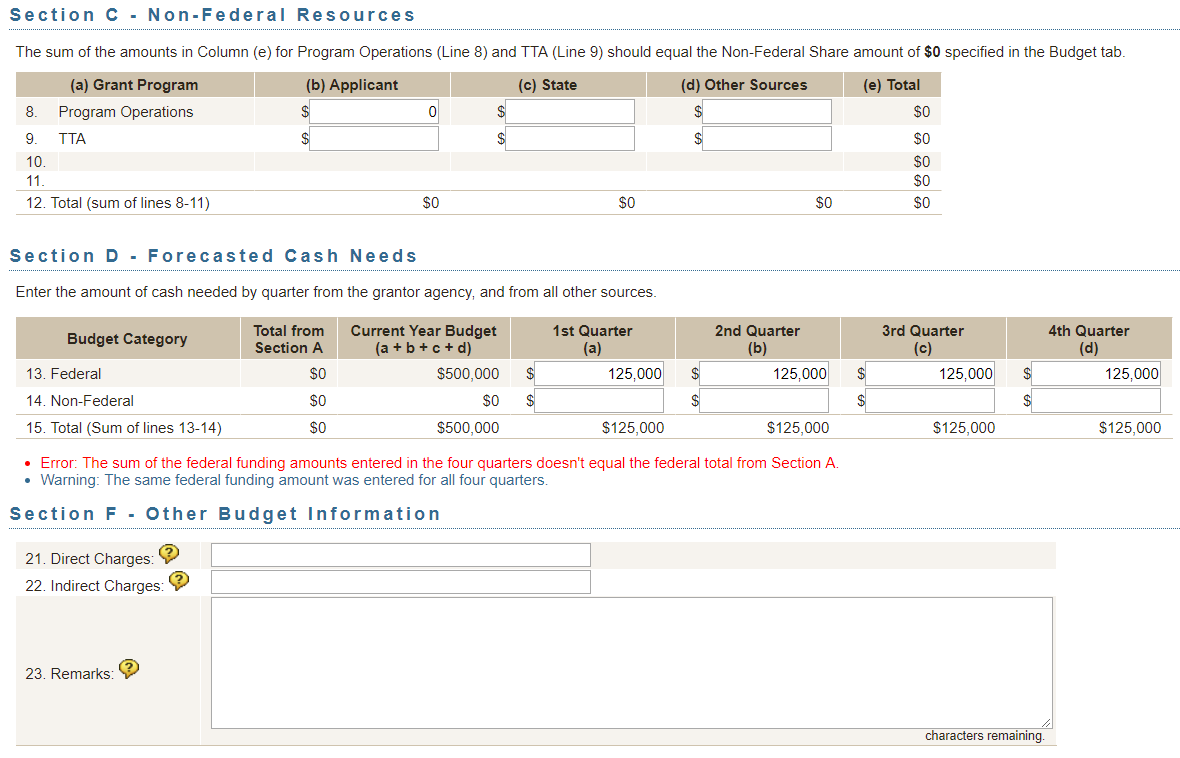
SF-424
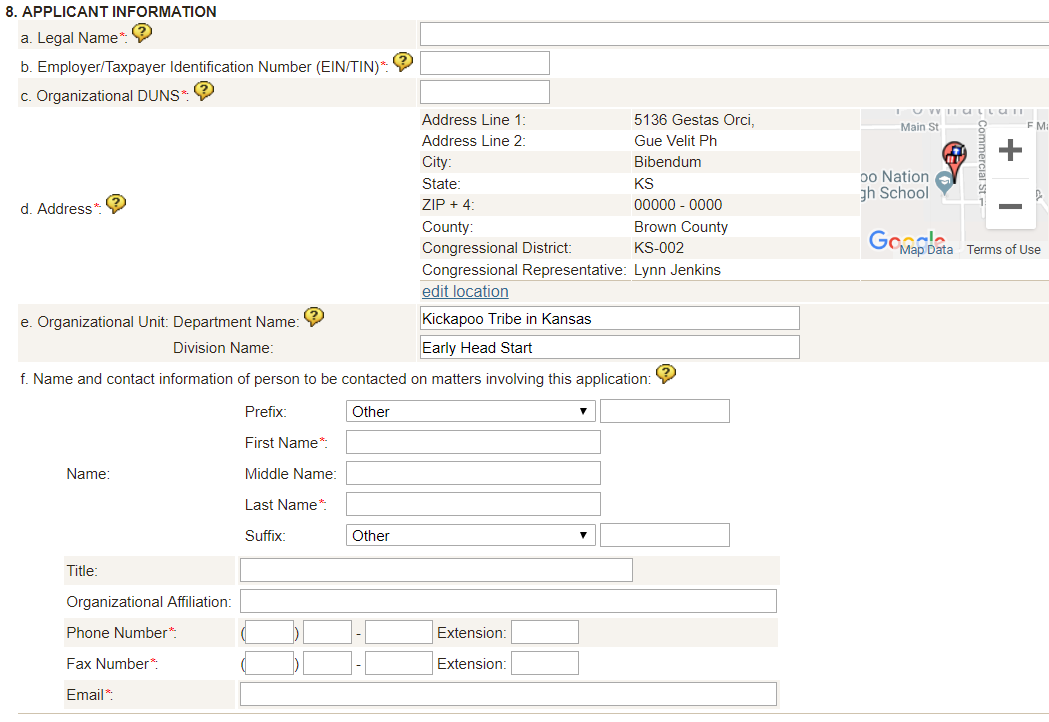
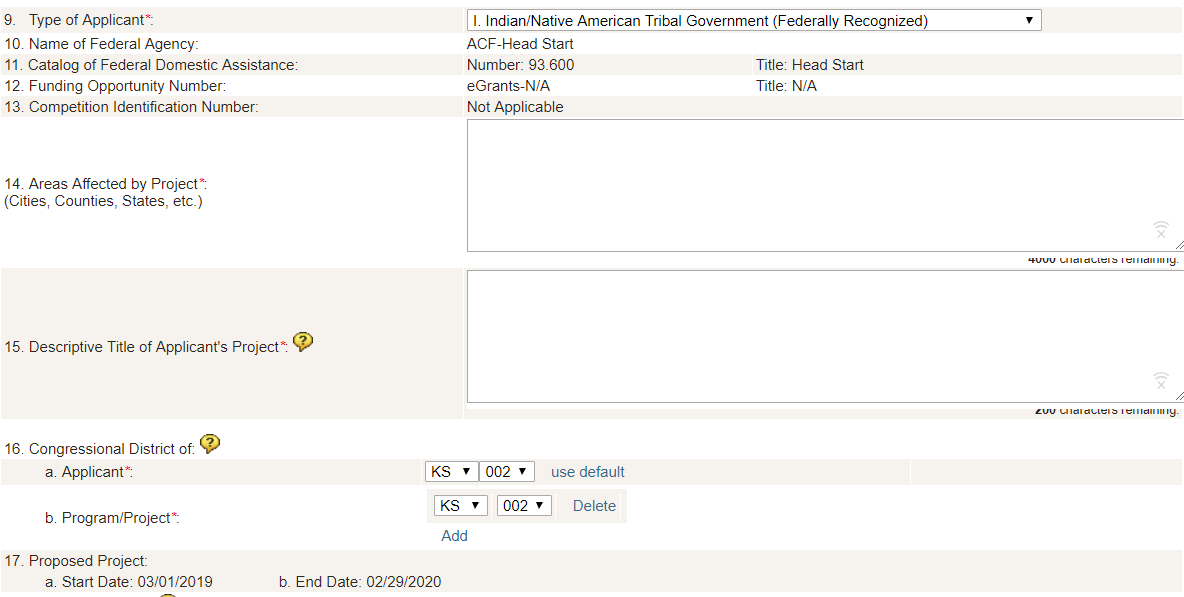

Grantee Change




Head Start Grant Application Instructions
with Guidance
Version 3


![]()
Table of Contents
Instructions for the Complete Grant Application Package 13
Instructions for the Application and Budget Justification Narrative 15


Special Instruction for Shortened Budget Periods 15
General Formatting Requirements 16
Additional Resources on Program Goals 17
Special Instruction on Supporting Documentation 17
Special Instruction on Community Assessment 17
Section I. Program Design and Approach to Service Delivery 18
Sub-Section B: Service Delivery 20
Sub-Section C: Governance, Organizational, and Management Structures 25
Section II. Budget and Budget Justification Narrative 27
Instructions for the Complete Grant Application Package
Submit the complete grant application package in an electronic format using the Head Start Enterprise System (HSES) at https://hses.ohs.acf.hhs.gov/hsprograms. The Grant Applications section is located under the “Financials” tab. Incomplete applications will not be processed.
A complete grant application package requires completing the following application tabs in HSES:
Program Schedule

Signed Assurances
After submitting the grant application, HSES automatically generates the following electronically signed assurances for download in the SF-424 tab:
SF-424B, Assurances – Non-Construction Programs;
Certification Regarding Lobbying;
Certification Regarding Compliance with Compensation Cap (Level II of Executive Schedule); and
Tax Certification Form.
Budget
Other Funding
SF-424A
SF-424
Documents
What documents do I upload in the Documents tab in HSES?
Upload the following documents in their respective folders of the Grant Application Documents tab in HSES. Do not upload any additional documents completed on-screen such as the SF-424 and signed assurances.
Documents to Upload in HSES |
Page Limit |
Related Citation |
Application and Budget Justification Narrative |
60 Pages* |
Instructions with Citations Begin on Page 5 |
Results of Self-assessment and Improvement Plan |
N/A |
|
Governing Body and Policy Council Decisions |
Head Start Act 642(c)(1)(E)(iv)(V) & 642(c)(2)(D)(iii) |
|
Selection Criteria *NEW* |
||
Cost Allocation Plan *NEW* |
||
Training and Technical Assistance Plan |
Head Start Act 648(d)(1) |
|
Annual Report to the Public *NEW* |
||
Program Goals, optional *NEW* |
|
|
Indirect Cost Rate Agreement, or records showing adoption of 10% de minimis indirect cost rate, if applicable |
Uniform Fiscal Regulations |
|
Other Supporting Documents, if applicable |
|
|
Sample Delegate and/or Partnership Contracts, if applicable |
|
*OHS understands some programs such as those with numerous delegates, complex models, significant changes, and very large grantees may exceed the page limit.
Governing Body and Policy Council Decisions
Upload governing body approval and policy council approval or disapproval of the application:
Signed statements of the governing body and policy council chairs;
Governing body and policy council minutes documenting each group’s participation in the development and approval of the application; and
If the policy council did not approve the application, upload the required letter from the policy council indicating its reasons for withholding approval.
Cost Allocation Plan
Upload a written cost allocation plan, certified in accordance with 45 CFR §75.415 that describes how shared costs, including shared staff, are allocated based on proportional benefit as required in 45 CFR §75.406. Indirect cost must be included unless the applicant has a negotiated indirect cost rate agreement or has adopted use of the 10% de minimis rate.
Training and Technical Assistance Plan
Upload the grantee’s plan for professional development of staff, parents, volunteers, governing body members and policy council members. Assure the plan addresses mandatory training and priorities identified from ongoing monitoring and the annual self-assessment.
Indirect Cost Rate Agreement
If applicable, upload a copy of the current or proposed negotiated indirect cost rate agreement between the agency and/or delegate agencies and the respective cognizant Federal agency. If using the 10% de minimis indirect cost rate, upload a copy of the policy or other written record indicating date upon which the rate was adopted.
Who should complete the grant application?
The completion of the grant application is a team effort. The application covers a wide range of topics and activities and it represents a grantee’s commitment to the implementation of the program and use of federal funds.
How do I receive assistance with application submission?
Please contact your Regional Office for assistance with the Application and Budget Justification Narrative instructions.
HSES training materials and a User’s Guide to support submission are found in the "Instructions" section of HSES. For further technical assistance, please contact [email protected] or 1-866-771-4737.
 Instructions
for the Application and Budget Justification Narrative
Instructions
for the Application and Budget Justification Narrative


 Introduction
Introduction

 Grantees
are required to submit funding applications for each year of the
project period. The Office of Head Start carefully considers each
grantee’s annual application, beginning with the baseline, to
assure that agencies are meeting the intent of the Head Start
mission, purpose, and regulations prior to issuing the Notice of
Award. The Office of Head Start analyzes each application to
understand whether the grantee’s proposed program design,
services, and resources are aligned to meet the needs of the children
and families in their community, and to understand the program’s
goals and progress toward meeting those goals, as well as outcomes,
throughout the grant’s project period.
Grantees
are required to submit funding applications for each year of the
project period. The Office of Head Start carefully considers each
grantee’s annual application, beginning with the baseline, to
assure that agencies are meeting the intent of the Head Start
mission, purpose, and regulations prior to issuing the Notice of
Award. The Office of Head Start analyzes each application to
understand whether the grantee’s proposed program design,
services, and resources are aligned to meet the needs of the children
and families in their community, and to understand the program’s
goals and progress toward meeting those goals, as well as outcomes,
throughout the grant’s project period.


Baseline
Application
In the Baseline Application, grantees describe the program design, goals, approach to service delivery, and supporting budget for the duration of their grant. This is an opportunity for the grantee to present their strategies for meeting certain requirements and to ensure the delivery of high quality services, including a program design that is responsive to the needs of the children and families in the community.
Grantees applying for a non-competitive new grant would follow the instructions for submitting a Baseline Application for the first year of the new grant. These grantees are in the final 12 months of their current grant.
Grantees that received a grant through the competitive process and are submitting their first grant application in HSES using these instructions would complete a Baseline Application. These grantees will submit their baseline a few months up to a year after the start of their competitive new grant depending on the length of their initial budget period.


Continuation
Application
Following the baseline for the duration of the project period, grantees submit a Continuation Application. In this application, grantees describe any changes to the program design, goals, approach to service delivery, and supporting budget. Grantees provide a rationale for changes such as resulting from ongoing oversight or using data for continuous improvement as described in 1302.102(b)-(c). Also, grantees describe challenges with implementing the program design and how they are working to address those challenges.
Special Instruction for Shortened Budget Periods
Grantees submitting an application for a budget period of less than 6 months must complete the budget and schedule tabs within HSES, and submit only a budget justification (Section II) for the Application and Budget Justification Narrative document; other tabs in HSES and supporting documents must also be completed. On the next application grantees must submit either a full baseline during the first year of the project period or a full continuation application if it is later in the project period.
 Reminder:
If you have any questions about the narrative instructions,
contact your Program Specialist.
Reminder:
If you have any questions about the narrative instructions,
contact your Program Specialist.
General Formatting Requirements
Provide a Table of Contents within the narrative document
Each page must be double-spaced, with one-inch margins on all sides.
Use a font size of 12 for narrative.
Each page must be numbered in the lower right-hand corner.
The application must follow the sequential order of the application instructions for the narrative. Tables, headers, and illustrations may have different formatting.
Terms and Definitions
Program Goals – Broad statements that describe what a program intends to accomplish. Program goals should be strategic, long term, and responsive to the needs identified in the community assessment. They include:
Goals for the provision of educational, health, nutritional, and family and community engagement program services to further promote the school readiness of enrolled children;

School readiness goals; and
Effective health and safety practices to ensure children are safe at all times (programs may wish to identify these as a stand-alone goal or as an objective related to another type of program goal, i.e. a health goal).

School Readiness Goals – The expectations of children's status and progress across domains of language and literacy development, cognition and general knowledge, approaches to learning, physical well-being and motor development, and social and emotional development that will improve their readiness for kindergarten (as defined in 45 CFR 1305.2).
Measurable Objectives – Support the attainment of goals that are Specific, Measurable, Attainable, Realistic and Timely (SMART).
Progress – Forward movement toward the achievement of goals, objectives, and outcomes.
Outcomes – Something that happened as a result of an activity or process. The actual results achieved.
Challenges – Information describing obstacles to achieving program goals and objectives.
Evidence – Facts, information, documentation, or examples given to support an assertion.
Additional Definitions
See Section 1305.2 of the HSPPS for additional definitions. For example, “service area”, “recruitment area”, and “Head Start Early Learning Outcomes Framework: Ages Birth to Five” are defined in this section.
Additional Resources on Program Goals
Training and Technical Assistance materials are available to help grantees complete their application narrative. See the “Foundations for Excellence: Five-Year Planning and Continuous Improvement, 2nd Edition” for additional assistance once released.
See Section 1302.102 of the HSPPS for requirements relating to achieving program goals.
Special Instruction on Supporting Documentation
A program must summarize critical information from supporting documentation into the narrative. For example, do not provide additional documents to respond to criteria in the instructions unless requested by the regional office.
Special Instruction on Community Assessment
The program must describe only those findings from the community assessment that informed the proposed program design and approach to service delivery throughout the narrative. Do not upload the full community assessment.
 Section
I. Program Design and Approach to Service Delivery
Section
I. Program Design and Approach to Service Delivery
Sub-Section A: Goals


Baseline
Application Instructions
What are your Program Goals, Measurable Objectives, and Expected Outcomes for the project period?
List all Program Goals
List all Measurable Objectives aligned to each program goal
To demonstrate the agency’s approach to measuring progress and outcomes, select a few Measurable Objectives and describe the following:
Activities or action steps to meet the objective
Data, Tools, or Methods for tracking Progress
Expected Outcomes
Expected Challenges
Only for grantees applying for a non-competitive new grant: Describe how your actual Outcomes from the prior project period informed the above.
Example

Program Goals |
Measurable Objective Description |
Goal 1 |
|
Goal 2 |
|
Goal 3 |
|
… |
… |
Select a few Measurable Objectives and provide the following to demonstrate the agency’s approach to measuring progress and outcomes:
EXAMPLE: Goal 2 – Measurable Objective B selected
(i) Description of activities or action steps to meet objective, (ii) data, tools, or methods for tracking progress, (iii) expected outcomes, and (iv) expected challenges for this objective
Continue with other selected measurable goals…
Explain how your program’s School Readiness Goals align with the Head Start Early Learning Outcomes Framework: Ages Birth to Five, state and tribal early learning guidelines, as appropriate, and requirements and expectations of the local schools where children will transition.
Discuss how your program involved governing body, policy council, and parents in developing the Program Goals.


Continuation
Application Instructions
If applicable, list any additions, deletions, or revisions to your Program Goals, Measurable Objectives, and Expected Outcomes that have occurred since last year’s application and briefly describe the reasons for those changes such as resulting from ongoing oversight or from using data for continuous improvement as described in 1302.102(b)-(c). If no updates or changes have occurred, include a sentence to that effect.
For each Program Goal:
Demonstrate your Progress/Outcomes this year toward meeting your Measurable Objectives and Expected Outcomes.
Describe any Challenges in achieving progress towards Expected Outcomes and how your program is working to address those Challenges.
Example

Program Goals |
Measurable Objectives |
Progress/Outcomes |
Challenges |
Goal 1 |
A |
Description |
Description |
B |
|
|
|
Goal 2 |
A |
|
|
B |
|
|
|
C |
|
|
|
Goal 3 |
A |
|
|
B |
|
|
|
… |
… |
… |
… |
If additions, deletions, or revisions were made to your program’s School Readiness Goals since last year’s application, then describe how the revised goals align with the Head Start Early Learning Outcomes Framework: Ages Birth to Five, state and tribal early learning guidelines, as appropriate, and requirements and expectations of the local schools where children will transition.
If additions, deletions, or revisions were made to your Program Goals since last year’s application, then include information on how parents and the governing body were involved in those changes.
Sub-Section B: Service Delivery


Baseline
Application Instructions
 In
this sub-section, describe your program’s approach to meeting
the need for comprehensive child development services for eligible
children and families in your service area.
In
this sub-section, describe your program’s approach to meeting
the need for comprehensive child development services for eligible
children and families in your service area.
Tip: The HSPPS provides additional information on the requirements for each topic and it is helpful to follow the HSPPS alongside these instructions.
Service and Recruitment Area (see 1302.11(a) and 1302.13):
Identify the service and recruitment area for proposed program operations.
Provide Evidence to demonstrate that the proposed area is the area of greatest need.

If child care partners are proposed, identify the number of children proposed to be served through partnership slots.
Reminder: If applicable, upload a sample delegate and/or partnership contract to the Documents tab.
Needs of Children and Families (see 1302.11(b) and Special Instruction on Community Assessment):
Provide a summary of data from your community assessment that informs the program’s selection criteria and design, such as:the estimated number of eligible children under five years of age and pregnant women by geographic location, race, ethnicity, and spoken language, including children experiencing homelessness, in foster care, dual language learners, and with disabilities;
data regarding the education, health, nutrition, social service, child care, parent schedules, and other service needs of the proposed children, families, and pregnant women; and
the availability of other child development, child care centers, and family child care programs that serve eligible children, including home visiting, publicly-funded state and local preschools, and the approximate number of eligible children served.
Proposed Program Option(s) and Funded Enrollment Slots (see 1302 Subpart B and the HSPPS Compliance Table):
Specify the proposed program option(s) (i.e., center-based, home-based, and family child care) and describe how your program will ensure compliance with 1302 Subpart B requirements and other applicable requirements.
If requesting a locally-designed program option variation (LDO) waiver under 1302.24(c), then provide the following:
Identify the program(s), Head Start and/or Early Head Start, for which the waiver would apply.
Identify the requirement(s) for which the waiver would apply:
Center-based ratios and group size - cannot be waived for children < 24 months
Center-based duration
Selection of home based-only setting in Head Start
Home-based caseloads
Home-based duration
Family child care ratios and group size

Family child care duration
Note: The requirements in A-G above are the only ones that may be waived for this program option.
Describe the rationale for the request.
When waiving ratios and group sizes in center settings, specify how square footage will meet applicable requirements.
Specify the proposed timetable for implementation of the option.
Check to be certain the changes described are reflected in the program schedule tab.
Explain how the program will measure progress to assure the LDO effectively supports appropriate development and progress in children’s early learning outcomes.
If available, provide evidence that demonstrates the LDO variation is effective.
Discuss how your program option(s) will meet the needs of children and families in the communities served.
Funded Enrollment Changes. If proposing to change or convert the number of funded enrollment slots, explain the rationale.
Provide the funding amount for the Head Start and Early Head Start programs before and after the change.
Specify the number of Head Start and Early Head Start slots before and after the change.
If proposing to convert Head Start slots to Early Head Start slots, then:
Describe how the needs of eligible Head Start children will be met in the community when the conversion takes place.
Describe how the chosen model(s) meets the needs of infants, toddlers, and pregnant women.
Discuss the agency’s capacity to carry out an effective Early Head Start program.
Discuss the qualifications, competencies, and training of staff, and describe the facilities and program infrastructure to support the new or expanded Early Head Start program.

Specify the proposed timetable for implementation of the conversion.
 Reminder:
Complete the “Program
Schedule” tab for Head Start and/or Early Head Start.
Reminder:
Complete the “Program
Schedule” tab for Head Start and/or Early Head Start.
Note: If proposing Funded Enrollment Changes, indicate the application includes a “Change in Scope” request in HSES.
Centers and Facilities:
List any additions, deletions, or changes to your service locations, including partners, and describe the reasons for changes.
Describe any minor renovations and repairs included within this application (not subject to a separate 1303 Subpart E application).


Describe any facilities activities that are subject to 1303 Subpart E, e.g., purchase, construction, major renovation, loan or mortgage, and subordination agreement.
 Reminder:
Review the “Centers” tab in HSES to ensure all
information is up-to-date.
Reminder:
Review the “Centers” tab in HSES to ensure all
information is up-to-date.
Note: Funds for facilities activities subject to 1303 Subpart E must be requested in a separate 1303 Subpart E Application and the SF-429 Real Property Status Report Cover Page and its relevant Attachment(s). Also, real property status is reported annually using the SF-429 Real Property Status Report Cover Page and Attachment A.
Eligibility, Recruitment, Selection, Enrollment, and Attendance (see 1302.13, 1302.14, 1302.15, and 1302.16):
Describe the recruitment process to ensure services will be provided to those in greatest need of program services.
Describe specific efforts and expected challenges to actively locate, recruit, and enroll vulnerable children, including children with disabilities, children experiencing homelessness, and children in foster care.
Describe your program’s strategy to promote regular attendance including special efforts for chronically absent children and other vulnerable children.
Education and Child Development (see 1302 Subpart C):
If center-based or family child care program option is chosen, respond to item a, and c through d. If home-based program option is chosen, respond to items b through d. If locally designed program option is chosen, respond to items that apply. Programs that serve American Indian and Alaska Native (AIAN) children also respond to item e.
Center-based or family child care programs:
Identify the curriculum(a) your program will use including, if applicable, curricular enhancements and/or significant adaptations.
Describe how each identified curriculum is appropriate for ages and background of children served, research-based, and has an organized developmental scope and sequence.
Include Evidence that each curriculum is aligned with the Head Start Early Learning Outcomes Framework: Ages Birth to Five.
Describe how your program will support staff to implement curriculum with fidelity.
Home-based programs:
Identify the home-based curriculum(a) your program will use including, if applicable, curricular enhancements and/or significant adaptations
Describe how each curriculum is appropriate for ages and background of children served, research-based, promotes the parent’s role as the child’s teacher including, as appropriate, the family’s traditions, culture, values, and beliefs, and has an organized developmental scope and sequence, and how it is aligned with the Head Start Early Learning Outcomes Framework: Ages Birth to Five.
Describe how your program will support staff to implement the curriculum.
Describe group socializations to be offered.
Identify the developmental screenings and assessments your program plans to use and why, including how the program addresses screening and assessment for children who are dual language learners.
Describe opportunities offered to parents and family members to be engaged in their child’s education such as participation in screenings and assessment, and providing feedback on the selected curriculum and instructional materials.
For programs serving AIAN children, and where applicable, describe efforts for Tribal language preservation, revitalization, restoration, or maintenance.
Health (see 1302 Subpart D):
Describe how your program will, in partnership with parents, meet the oral health, nutritional, and mental health and social and emotional well-being, and health status and care needs of children that are developmentally, culturally, and linguistically appropriate and support each child’s growth and school readiness:
Include how your program will ensure up-to-date child health status, ongoing care, and timely follow-up care.
For mental health and social and emotional well-being, describe how a program will provide mental health consultation services in partnership with staff and families.
Family and Community Engagement (see 1302 Subpart E):
Describe key program strategies for building trusting and respectful relationships with families and for providing program environments and services that are welcoming and culturally and linguistically responsive to families, including those specific to fathers.
Describe engagement activities to support parent-child relationships, child development, family literacy, and language development including supporting bilingualism and biliteracy.
Describe how your program has selected and is implementing a research-based parenting curriculum. Describe how your program engages parents in a research-based parenting curriculum.
Describe key program strategies for family partnership services, including:
Procedures for conducting the family assessment and family partnership process and aligning activities to the Parent, Family, and Community Engagement Framework outcomes; and
Tracking progress toward individual family goals and needs.
Provide a few examples of community partnerships that facilitate access to services or resources in the community that are responsive to family partnership goals and children’s needs. Identify any challenges to necessary partnerships and how the program plans to address those challenges.
Services for Children with Disabilities (1302 Subpart F):
Describe how your program will ensure the full participation in program services and activities for enrolled children with disabilities, including but not limited to those who are eligible for services under IDEA and those who already have an IFSP or IEP.
Describe how your program will ensure the individualized needs of children with disabilities are met, including how the program will collaborate with and help parents in the process and how the program will coordinate and collaborate with the local agency responsible for implementing IDEA.
Transition (see 1302 Subpart G):
Describe strategies and practices to support successful transitions in:
Transitions to and from Early Head Start;
Transitions from Head Start to kindergarten; and
Transitions between programs.
Services to Enrolled Pregnant Women (see 1302 Subpart H):
Describe how your program facilitates access to a source of ongoing care for enrolled pregnant women that do not have existing access to such care.
Describe your program’s strategy to provide prenatal and postpartum information, education, and services such as those that address fetal development, nutrition, risks of alcohol and drugs, postpartum recovery, and infant care and safe sleep practices.
Describe how your program’s family partnership services includes a focus on factors that influence prenatal and postpartum maternal and infant health, includes other relevant family members, and support the transition process.
Transportation (see 1303 Subpart F):
Describe the level of need for child transportation services.
Describe how your program will either directly meet transportation needs or assist families in accessing other transportation so that children can attend the program.


Continuation
Application Instructions
Provide updates to the following areas. Describe the rationale for any changes to your program design such as new data from an updated community assessment, ongoing oversight, or from using data for continuous improvement as described in 1302.102(b)-(c). If there are no updates or changes, include a sentence to that effect. Where applicable, describe any challenges and how the program is working to address those challenges.
Service and Recruitment Area
Needs of Children and Families
Chosen Program Option(s) and Funded Enrollment Slots
Centers and Facilities
Eligibility, Recruitment, Selection, Enrollment, and Attendance
Education and Child Development
Health
Family and Community Engagement
Services for Children with Disabilities
Transition
Services to Enrolled Pregnant Women

Transportation
 Tip:
See instructions from the Baseline
Application for additional detail on each category.
Tip:
See instructions from the Baseline
Application for additional detail on each category.
Reminder: Make sure all HSES tabs are updated (e.g., Program Schedules, Centers, and Delegates)
Sub-Section C: Governance, Organizational, and Management Structures


Baseline
Application Instructions
In this section, describe the governance, organizational, and management structures that support quality services and maintain accountability, efficiency, and leadership within your program.
 Tip:
Grantees are encouraged to use the Head
Start Management Wheel as a reference tool.
Tip:
Grantees are encouraged to use the Head
Start Management Wheel as a reference tool.
Governance (see 45 CFR Part 1301 and Section 642(c)-(d) in the Act):
Structure
Identify the member (i) with expertise in fiscal management or accounting, (ii) with expertise in early childhood education and development, and (iii) the licensed attorney familiar with program governance issues in the governing body/tribal council.
Describe how your program ensures additional members on the governing body reflect the community, including parents and representation from other key programmatic areas.
Describe the makeup of the policy council or if applicable, the policy committee. Include how each program option is represented.
Processes
Governing Body
Describe how the governing body receives key program information as outlined in 1301.2(b)(2) to inform their ongoing responsibilities including how decisions submitted by the policy council are incorporated into the decision-making process. Describe other key processes to ensure the governing body maintains effective ongoing oversight of program operations and accountability for federal funds.
If applicable, describe and explain the responsibilities delegated to any advisory committee related to program governance and improvement of the Head Start program. Include how the governing body maintains its legal and fiscal responsibility in the process.
Policy Council and Policy Committee
Describe how the policy council, and if applicable, the policy committee, receives and shares key program information as outlined 1301.3(c)(2) to inform their ongoing responsibilities.
Parent Committees
Describe how the parent committees communicate with staff to inform program policies, activities, and services to ensure they meet the needs of children and families.
Describe the process for communication with the policy council and policy committees.
Relationships
Describe training and technical assistance or orientation sessions for the governing body, advisory committee members, and the policy council.
How does your program ensure governing body members do not have a conflict of interest with the Head Start, Early Head Start, and delegate programs or other partners/vendors? Describe any exception criteria applicable to a governing body member.
How do the governing body and policy council members ensure meaningful consultation and collaboration around their joint decisions?
Human Resources Management (see1302 Subpart I):
Provide an organizational chart identifying the management and staffing structure including the Executive Director, the Program Directors, managers, and other key staff. Include assigned areas of responsibility and lines of communication.
Describe systems developed to ensure criminal background checks occur prior to hire for all staff, consultants, and contractors in the program.
Describe orientations provided to new staff, consultants, and volunteers.
Describe key features of your program’s approach to staff training and professional development. Describe your program’s approach to implementing a research-based coordinated coaching strategy, including the approach to the delivery of intensive coaching for identified staff.
Program Management and Quality Improvement (see 1302 Subpart J):
Describe key features of your program’s systems for ongoing oversight, correction, and assessment of progress towards your program’s identified goals. Include approaches that promote effective teaching and health and safety practices.
Describe key features of your program’s management process and system to ensure continuous program improvement that relate to effectively using data and ongoing supervision to support individual staff professional development.
Describe how the management system ensures budget and staffing patterns that promote continuity of care, allow sufficient time for staff participation in training and professional development, and allow for provision of the full range of services.


Continuation
Application Instructions
Provide updates to the following areas. If changes were made, describe the rationale for the changes such as new data from an updated community assessment, ongoing oversight or from using data for continuous improvement as described in 1302.102(b)-(c). If no updates or changes have occurred, include a sentence to that effect. Where applicable, describe any challenges in these areas and how the program is working to address those challenges.
 Tip:
See Requirements for Baseline Application above for additional
detail on each category.
Tip:
See Requirements for Baseline Application above for additional
detail on each category.
Governance
When providing updates to Processes, include examples of the governing body and policy council using key program information (see 1301.2(b)(2) and 1301.3(c)(2)) to conduct its responsibilities. Also include examples of parent committees informing program policies, activities, and services.
Human Resources Management
Program Management and Quality Improvement
When providing updates, include pending corrective actions from ongoing oversight and any new procedures that prevent recurrence of previous quality and compliance issues, including previously identified noncompliances/deficiencies, safety incidents, and audit findings.


Section
II. Budget and Budget Justification Narrative



Baseline
and Continuation Application Instructions
 A
comprehensive
budget
aligns
with
the
proposed
program
approach
and
identifies
allowable
costs, and is
aggregated by object class category. Grantee and, if applicable, each
delegate agency must complete separate budgets for Head Start and
Early Head Start.
A
comprehensive
budget
aligns
with
the
proposed
program
approach
and
identifies
allowable
costs, and is
aggregated by object class category. Grantee and, if applicable, each
delegate agency must complete separate budgets for Head Start and
Early Head Start.
Reminder: Make relevant changes to application tabs in HSES where needed (e.g., Budget, SF-424).
Justify the budget by addressing the following:
Provide a detailed narrative to explain the costs by object class category identified within the SF-424A Section B-6. Explain significant personnel and fringe adjustments for this budget period for item a and b. For each item c through h, ensure the narrative aligns with the amounts requested for direct and, if applicable, indirect costs.
Identify and explain each delegate agency agreement, partnership contract, and any single item costing more than $150,000 in the “Contractual” and “Other” budget categories.
If applicable, describe the planned use of cost-of-living adjustment (COLA) funds based on the related Program Instruction.
Describe key features of the organization’s financial and property management system and internal controls in place to maintain effective control and accountability for grant funds, property, and other assets. See requirements for financial management at 45 CFR §75.302 and internal controls at §75.303.
Identify each source of non-federal match, including the estimated amount per source and the valuation methodology. Explain how your program determined that proposed non-federal match is allowable per 45 CFR §75.303 and Section 1303.4.
If proposing a waiver of the non-federal share match requirement, provide a detailed justification that conforms with the criteria under Section 640(b)(1)-(5) of the Act.
If proposing a waiver of the 15% limitation on development and administrative costs, provide a justification that meets the requirements of Section 1303.5 and contact your regional office for additional guidance.
If requesting an enrollment reduction request, describe the budget implications of the reduction request and any cost-savings measures considered prior to seeking the enrollment reduction.
If requesting a conversion (see Section 1302.20(c)):
Identify the amount of funds that will be re-allocated by object class category to convert Head Start to Early Head Start services. Explain the changes in each object class category.
Describe start-up costs from the annual operational funds that would be necessary to implement the proposed conversion request based on the timetable in item 3.d.iii.E of Sub-Section B of these instructions.
Discuss one-time funding necessary for the conversion and how the agency intends to secure such funding.
If requesting funds for the purchase, construction, or major renovation of facilities not previously approved, explain the need for and proposed use of such funds. Identify all proposed sources of funding for facilities activities and submit supporting documentation.
 Note:
For facility activities subject to Part
1303 Subpart E, a separate submission of form SF-429, with
Attachment B, and compliance with application requirements in Part
1303 Subpart E is required. No Head Start grant funds may be used
towards the cost of acquisition, construction, or major renovation of
a facility without the express prior written approval of the OHS and
ACF.
Note:
For facility activities subject to Part
1303 Subpart E, a separate submission of form SF-429, with
Attachment B, and compliance with application requirements in Part
1303 Subpart E is required. No Head Start grant funds may be used
towards the cost of acquisition, construction, or major renovation of
a facility without the express prior written approval of the OHS and
ACF.
If requesting funds for equipment, describe the procurement procedures to be followed for the purchase of such equipment. See equipment definition at 45 CFR §75.2.
| File Type | application/vnd.openxmlformats-officedocument.wordprocessingml.document |
| File Title | Application Instructions for 5 Year Head Start Grants, V2 |
| Author | Office of Head Start (OHS), ACF, HHS |
| File Modified | 0000-00-00 |
| File Created | 2021-01-13 |
© 2026 OMB.report | Privacy Policy